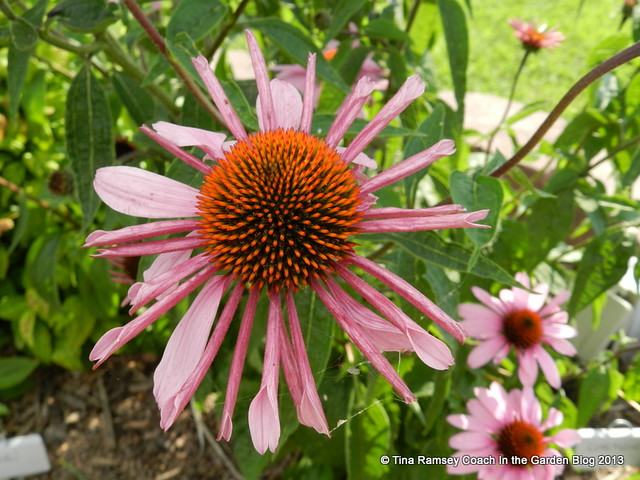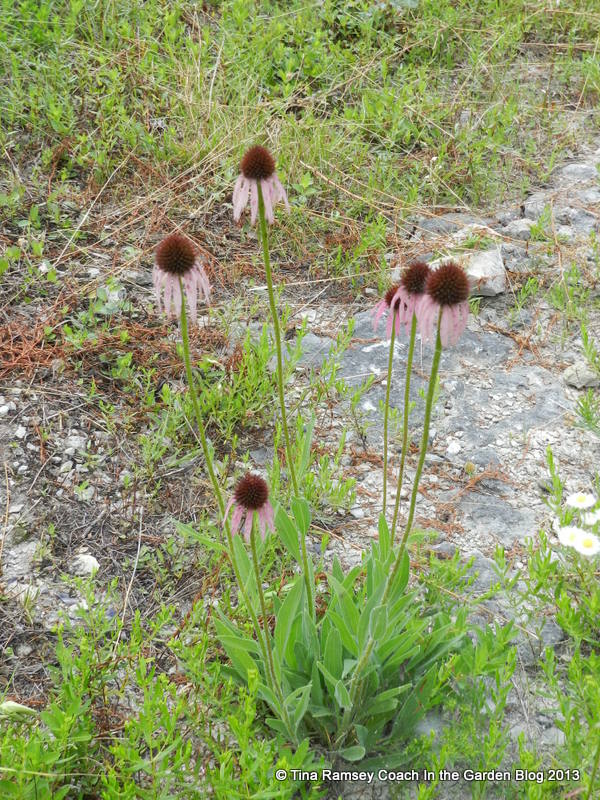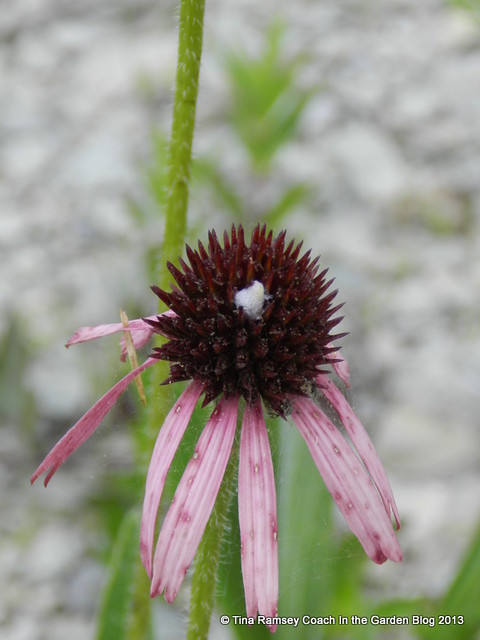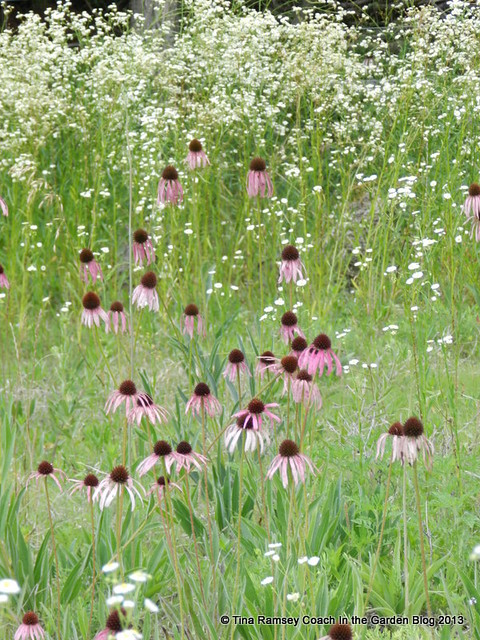
Echinacea purpurea hybrid
Just about everyone who has ever picked up a trowel knows what a coneflower looks like and most likely even grows some coneflowers or has grown them. The familiar purple coneflower (Echinacea purpurea) is a big butterfly draw and is such a nice drought tolerant plant with tons of blooms in the summer that one simply cannot help but to grow them.

This post is about coneflowers but not the familiar one we all know that you saw in the first picture; no, this post is about the pale coneflower, Echinacea pallida. All pictures after the first one are of the pale coneflower. There are several differences between the purple and pale coneflowers that include not only their looks but how they grow.

The pale coneflower is quite different from the normal purple coneflower in that its petals reflex down, it has a rather large taproot, and its foliage is clustered mostly at the base of the plant. The pale coneflower is also quite a hairy coneflower. Also, this coneflower is a protected species in many states due to the fact that many plant collectors have over harvested wild stands of this coneflower for the roots; which are used in herbal medicines. If you look closely at the second picture of this post you might notice someone (most likely the property owner) has installed a blue rope fence to protect the pale coneflowers from would be collectors of this treasure on the side of a Kentucky country road.

I have never seen these growing in the wild but I happen to have an awesomely knowledgeable gardening friend who is quite well acquainted with the local area and this particular stand of pale coneflowers. It was about six years ago Sandy mentioned to me this special place. I am most ashamed to say it has taken me all these years to finally get together with her to go and visit it just this past Wednesday.

I don't personally grow pale coneflowers and honestly don't think they would grow well on my farm but I do have to appreciate these tough coneflowers growing in gravel with no care from a gardeners hand. I have read where these coneflowers, unlike the purple coneflowers, like tough conditions and can be found growing in glades, limestone outcrops, and other gravelly areas that have a high pH. The pH on my farm is very low so right there that tells me there is a red light for them to grow on the farm. I also think these coneflowers would be much harder to transplant than the purple coneflowers due to the very large taproot the pale coneflowers have. That very taproot is what allows this coneflower to be very drought tolerant. Drought tolerance is a trait both pale and purple coneflowers do share.

These are native coneflowers and are very beautiful when found growing in the wild. Just look at how perfectly they photograph with what I believe to be some type of erigeron. I so enjoyed my outing with Sandy and was quite impressed with these lovely native wildflowers....
in the garden...
Hmmmmm. It seems like I have seen this before and thought it was just a very tired purpurea. ha. I will take a better look next time I see petals drooping.
ReplyDeleteWhat an amazing sight! Purple coneflowers are my favorite, perhaps because they were the first perennials I had success with when I first began gardening. I've seen a few of the Pallida in a prairie restoration area here, but there's supposed to be a whole stand of them in an old cemetery not too far north from us. I've always wanted to visit that cemetery--supposedly virgin prairie--this time of year to see the coneflowers, but I've never done it. I'm glad you were finally able to visit this site in Kentucky and shared it with us, Tina. The last photo is just beautiful!
ReplyDeleteOh, and I did plant one or two of these that I purchased from a native plant sale this spring; as wet as it's been here this year, I'm not sure if they're going to make it, but I have my fingers crossed.
I saw his rope immediately. It is good he has a means to have people keep off, and nice he protects them.
ReplyDeleteI love those!! I didn't realize they were drought tolerant.
ReplyDeleteNice to see these in the wild. I added them and the common native echinacea to my meadow...love these and they grow in my clay soil which amazed me.
ReplyDeleteAlways love wildflower s :)
ReplyDeleteI've never heard of the Pale coneflower .Didn't know they were protected either. That is great. More beauty on the side road to enjoy.
ReplyDeleteI love cornflowers. There's a whimsical beauty to them. Many thanks.
ReplyDeleteGreetings from London.
They look great across that meadow.
ReplyDeleteThe native coneflowers here are 'hunted' when the price for their roots gets high. I know ranchers who have had to call the sheriff to get the hunters off their land.
Most interesting Tina. We have a similar one but not quite so pale on our protected prairier and State Parks. Can't think of the name though....:)
ReplyDeleteIt's just amazing what lies beyond our well-traveled path, isn't it? Equally amazing how brazen some people are, just to get a few bucks for a plant. I've noticed that things have disappeared from our Asheville home place, especially pink lady's slipper, iris reticulata and other woodland plants. Hard to imagine who would do this. I enjoyed this post, Tina, and by the way, saw American columbo here in Asheville a few days ago. Thought of you....
ReplyDeleteDon't forget the Tennessee coneflower (Echinacea tennesseensis), which was recently removed from the federal endangered list. It can be found in several state parks around middle Tennessee in natural glade areas. It's petals point outward and sometimes upward. Its color is pale to brighter pink. I grow it in my yard from seeds I purchased from a native plant nursery. It handles out weather very well.
ReplyDeleteInteresting post Tina. At first when I saw the rope, I thought you had these growing wild on your new land! Ha, you got me on that one. I am a TN native and never in my life have I noticed the wild coneflower along the roadside. I reckon when I lived in TN as a child and young adult, I just did not take notice of them. I will be sure to keep my eyes open so as to capture a glimpse as we travel down a nice country road in the future. Hum, wonder if we have them in GA...
ReplyDelete